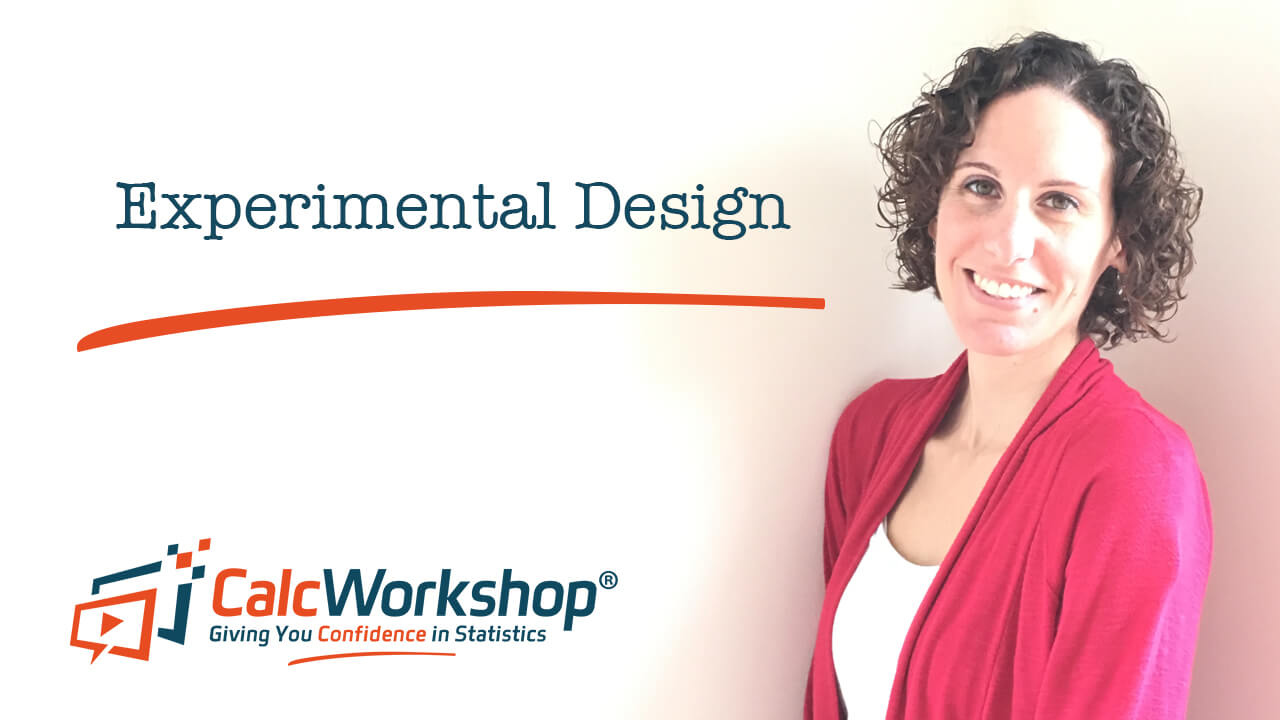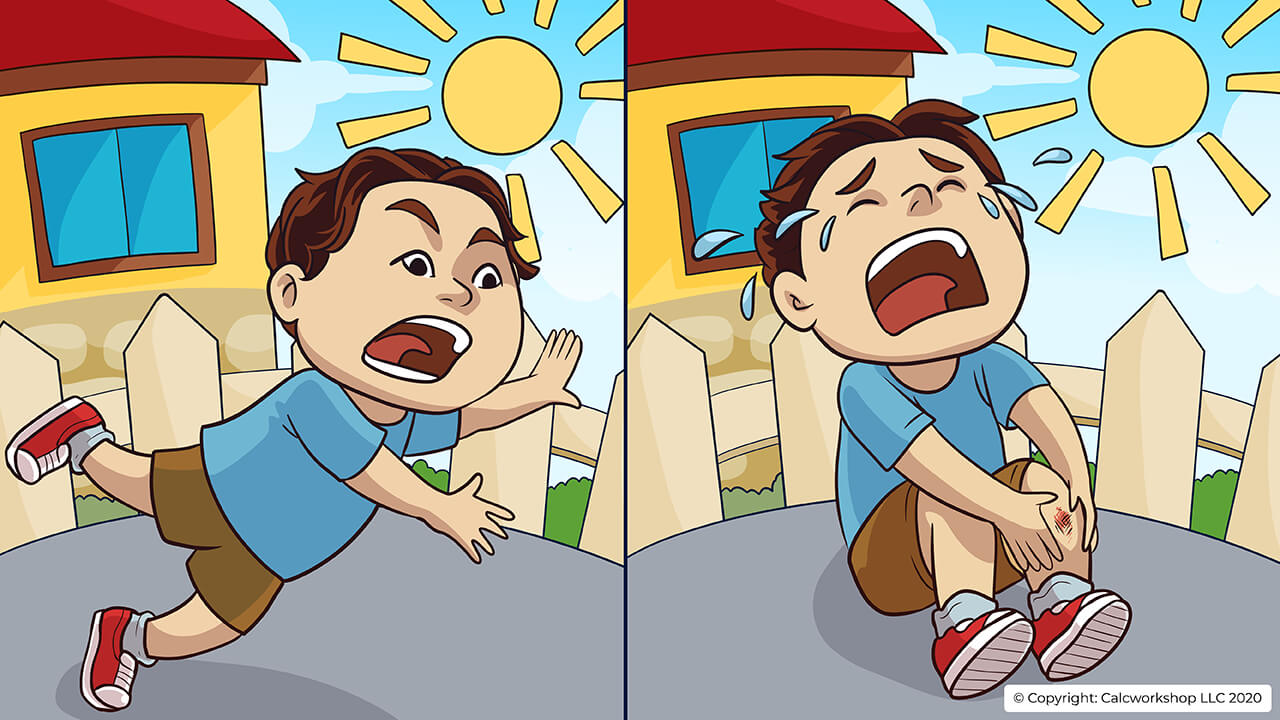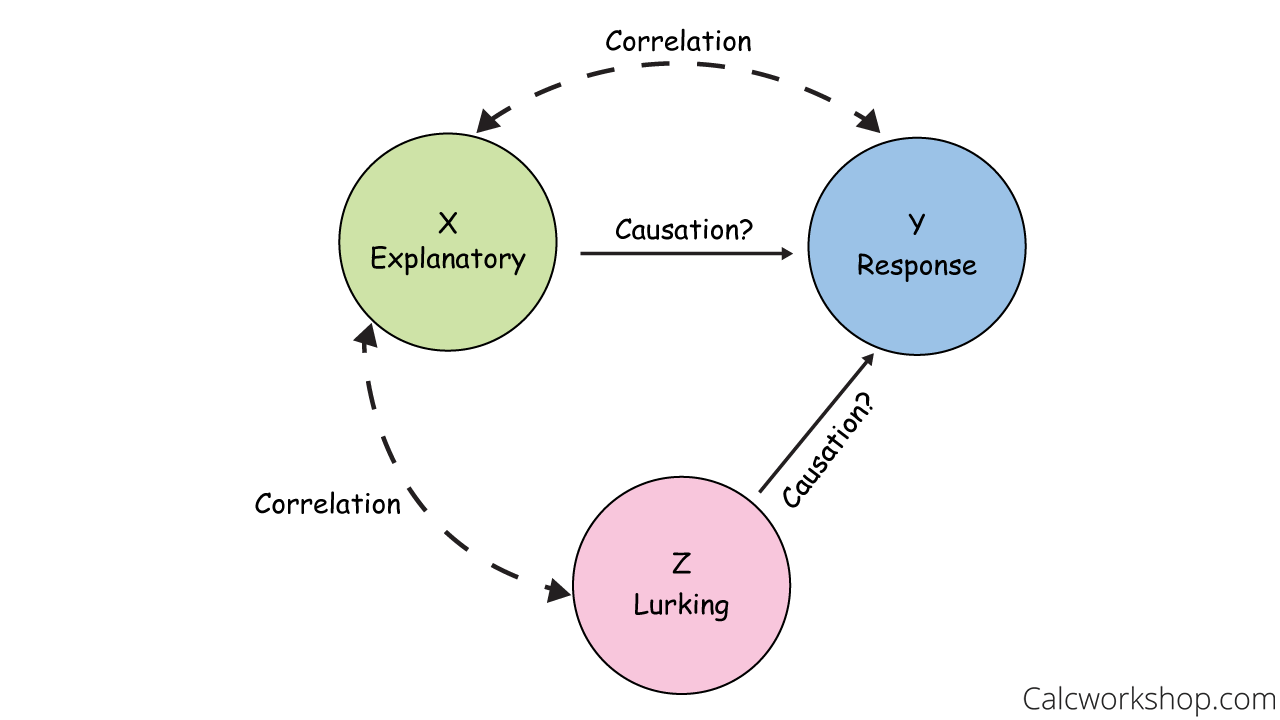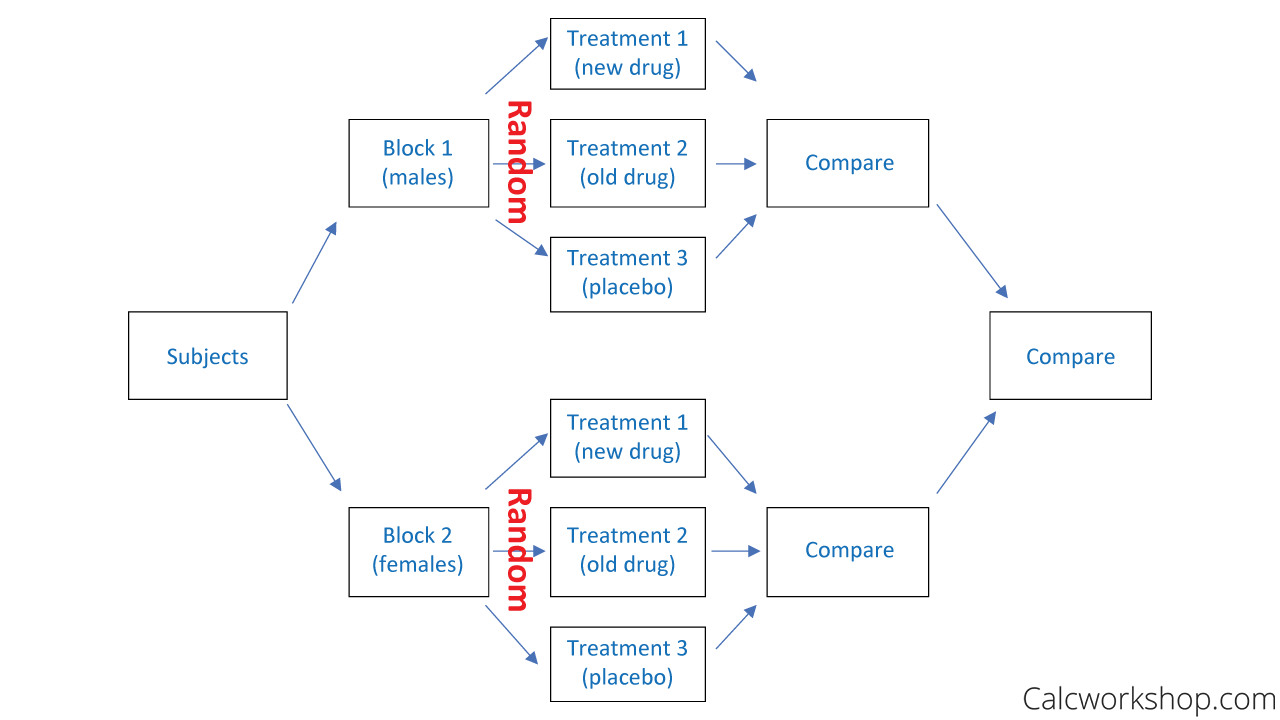Calcworkshop

Experimental Design in Statistics w/ 11 Examples!
// Last Updated: September 20, 2020 - Watch Video //
A proper experimental design is a critical skill in statistics.

Jenn, Founder Calcworkshop ® , 15+ Years Experience (Licensed & Certified Teacher)
Without proper controls and safeguards, unintended consequences can ruin our study and lead to wrong conclusions.
So let’s dive in to see what’s this is all about!
What’s the difference between an observational study and an experimental study?
An observational study is one in which investigators merely measure variables of interest without influencing the subjects.
And an experiment is a study in which investigators administer some form of treatment on one or more groups?
In other words, an observation is hands-off, whereas an experiment is hands-on.
So what’s the purpose of an experiment?
To establish causation (i.e., cause and effect).
All this means is that we wish to determine the effect an independent explanatory variable has on a dependent response variable.
The explanatory variable explains a response, similar to a child falling and skins their knee and starting to cry. The child is crying in response to falling and skinning their knee. So the explanatory variable is the fall, and the response variable is crying.

Explanatory Vs Response Variable In Everyday Life
Let’s look at another example. Suppose a medical journal describes two studies in which subjects who had a seizure were randomly assigned to two different treatments:
- No treatment.
- A high dose of vitamin C.
The subjects were observed for a year, and the number of seizures for each subject was recorded. Identify the explanatory variable (independent variable), response variable (dependent variable), and include the experimental units.
The explanatory variable is whether the subject received either no treatment or a high dose of vitamin C. The response variable is whether the subject had a seizure during the time of the study. The experimental units in this study are the subjects who recently had a seizure.
Okay, so using the example above, notice that one of the groups did not receive treatment. This group is called a control group and acts as a baseline to see how a new treatment differs from those who don’t receive treatment. Typically, the control group is given something called a placebo, a substance designed to resemble medicine but does not contain an active drug component. A placebo is a dummy treatment, and should not have a physical effect on a person.
Before we talk about the characteristics of a well-designed experiment, we need to discuss some things to look out for:
- Confounding
- Lurking variables
Confounding happens when two explanatory variables are both associated with a response variable and also associated with each other, causing the investigator not to be able to identify their effects and the response variable separately.
A lurking variable is usually unobserved at the time of the study, which influences the association between the two variables of interest. In essence, a lurking variable is a third variable that is not measured in the study but may change the response variable.
For example, a study reported a relationship between smoking and health. A study of 1430 women were asked whether they smoked. Ten years later, a follow-up survey observed whether each woman was still alive or deceased. The researchers studied the possible link between whether a woman smoked and whether she survived the 10-year study period. They reported that:
- 21% of the smokers died
- 32% of the nonsmokers died
So, is smoking beneficial to your health, or is there something that could explain how this happened?
Older women are less likely to be smokers, and older women are more likely to die. Because age is a variable that influences the explanatory and response variable, it is considered a confounding variable.
But does smoking cause death?
Notice that the lurking variable, age, can also be a contributing factor. While there is a correlation between smoking and mortality, and also a correlation between smoking and age, we aren’t 100% sure that they are the cause of the mortality rate in women.

Lurking – Confounding – Correlation – Causation Diagram
Now, something important to point out is that a lurking variable is one that is not measured in the study that could influence the results. Using the example above, some other possible lurking variables are:
- Stress Level.
These variables were not measured in the study but could influence smoking habits as well as mortality rates.
What is important to note about the difference between confounding and lurking variables is that a confounding variable is measured in a study, while a lurking variable is not.
Additionally, correlation does not imply causation!
Alright, so now it’s time to talk about blinding: single-blind, double-blind experiments, as well as the placebo effect.
A single-blind experiment is when the subjects are unaware of which treatment they are receiving, but the investigator measuring the responses knows what treatments are going to which subject. In other words, the researcher knows which individual gets the placebo and which ones receive the experimental treatment. One major pitfall for this type of design is that the researcher may consciously or unconsciously influence the subject since they know who is receiving treatment and who isn’t.
A double-blind experiment is when both the subjects and investigator do not know who receives the placebo and who receives the treatment. A double-blind model is considered the best model for clinical trials as it eliminates the possibility of bias on the part of the researcher and the possibility of producing a placebo effect from the subject.
The placebo effect is when a subject has an effect or response to a fake treatment because they “believe” that the result should occur as noted by Yale . For example, a person struggling with insomnia takes a placebo (sugar pill) but instantly falls asleep because they believe they are receiving a sleep aid like Ambien or Lunesta.

Placebo Effect – Real Life Example
So, what are the three primary requirements for a well-designed experiment?
- Randomization
In a controlled experiment , the researchers, or investigators, decide which subjects are assigned to a control group and which subjects are assigned to a treatment group. In doing so, we ensure that the control and treatment groups are as similar as possible, and limit possible confounding influences such as lurking variables. A replicated experiment that is repeated on many different subjects helps reduce the chance of variation on the results. And randomization means we randomly assign subjects into control and treatment groups.
When subjects are divided into control groups and treatment groups randomly, we can use probability to predict the differences we expect to observe. If the differences between the two groups are higher than what we would expect to see naturally (by chance), we say that the results are statistically significant.
For example, if it is surmised that a new medicine reduces the effects of illness from 72 hours to 71 hours, this would not be considered statistically significant. The difference from 72 hours to 71 hours is not substantial enough to support that the observed effect was due to something other than normal random variation.
Now there are two major types of designs:
- Completely-Randomized Design (CRD)
- Block Design
A completely randomized design is the process of assigning subjects to control and treatment groups using probability, as seen in the flow diagram below.

Completely Randomized Design Example
A block design is a research method that places subjects into groups of similar experimental units or conditions, like age or gender, and then assign subjects to control and treatment groups using probability, as shown below.

Randomized Block Design Example
Additionally, a useful and particular case of a blocking strategy is something called a matched-pair design . This is when two variables are paired to control for lurking variables.
For example, imagine we want to study if walking daily improved blood pressure. If the blood pressure for five subjects is measured at the beginning of the study and then again after participating in a walking program for one month, then the observations would be considered dependent samples because the same five subjects are used in the before and after observations; thus, a matched-pair design.
Please note that our video lesson will not focus on quasi-experiments. A quasi experimental design lacks random assignments; therefore, the independent variable can be manipulated prior to measuring the dependent variable, which may lead to confounding. For the sake of our lesson, and all future lessons, we will be using research methods where random sampling and experimental designs are used.
Together we will learn how to identify explanatory variables (independent variable) and response variables (dependent variables), understand and define confounding and lurking variables, see the effects of single-blind and double-blind experiments, and design randomized and block experiments.
Experimental Designs – Lesson & Examples (Video)
1 hr 06 min
- Introduction to Video: Experiments
- 00:00:29 – Observational Study vs Experimental Study and Response and Explanatory Variables (Examples #1-4)
- Exclusive Content for Members Only
- 00:09:15 – Identify the response and explanatory variables and the experimental units and treatment (Examples #5-6)
- 00:14:47 – Introduction of lurking variables and confounding with ice cream and homicide example
- 00:18:57 – Lurking variables, Confounding, Placebo Effect, Single Blind and Double Blind Experiments (Example #7)
- 00:27:20 – What was the placebo effect and was the experiment single or double blind? (Example #8)
- 00:30:36 – Characteristics of a well designed and constructed experiment that is statistically significant
- 00:35:08 – Overview of Complete Randomized Design, Block Design and Matched Pair Design
- 00:44:23 – Design and experiment using complete randomized design or a block design (Examples #9-10)
- 00:56:09 – Identify the response and explanatory variables, experimental units, lurking variables, and design an experiment to test a new drug (Example #11)
- Practice Problems with Step-by-Step Solutions
- Chapter Tests with Video Solutions
Get access to all the courses and over 450 HD videos with your subscription
Monthly and Yearly Plans Available
Get My Subscription Now
Still wondering if CalcWorkshop is right for you? Take a Tour and find out how a membership can take the struggle out of learning math.

Experimental Design
Experimental design refers to the process of planning and conducting an experiment to investigate cause-and-effect relationships between variables. It involves defining treatments, assigning participants to different groups, and controlling for confounding factors to ensure valid results.
Related terms
Control Group : A group in an experiment that does not receive any treatment or intervention. It serves as a baseline for comparison against the experimental group(s).
Randomization : The process of assigning participants or subjects to different treatment groups randomly. It helps minimize bias and ensures that each participant has an equal chance of being assigned to any group.
Confounding Variable : An extraneous variable that is not intentionally controlled but may influence the outcome of an experiment. It can lead to inaccurate conclusions if not properly accounted for in the design.
" Experimental Design " appears in:
Study guides ( 3 ).
- AP Statistics - 3.5 Introduction to Experimental Design
- AP Statistics - 3.6 Selecting an Experimental Design
- AP Statistics - 8.5 Setting Up a Chi-Square Test for Homogeneity or Independence
Subjects ( 2 )
- AP Physics 2
- AP Psychology
Practice Questions ( 1 )
- Which experimental design should be used in a study of college students' grades considering major and course load as factors?

Additional resources ( 3 )
- AP Statistics - Unit 3 Overview: Collecting Data
- AP Statistics - Unit 6 Overview: Inference for Categorical Data: Proportions
- AP Statistics - Unit 7 Overview: Means
© 2024 Fiveable Inc. All rights reserved.
Ap® and sat® are trademarks registered by the college board, which is not affiliated with, and does not endorse this website..
Helping math teachers bring statistics to life

Designing Experiments ( Topic 3.5 )
Chapter 4 - day 7, day 12 day 13, learning targets.
Describe the placebo effect and the purpose of blinding in an experiment.
Describe how to randomly assign treatments in an experiment using slips of paper, technology, or a table of random digits.
Explain the purpose of comparison, random assignment, control, and replication in an experiment.
Activity: Would You Fall for That?

Answer Key:
Start by showing this video .
This activity is getting students to start thinking about the Caffeine Experiment, which we use as a review day before the Chapter 4 Test.
There are a lot of ideas in the learning targets in this lesson. You have to be very intentional in the Debrief and Big Ideas to be sure that you are addressing all of them.
The Language of Experiments
Suppose that we thought that the temperature of the Coca Cola might also effect the pulse rate. So not only are we using Coke and Caffeine Free Coke, we are also testing it at 35 degrees, 50 degrees, and 70 degrees.
Factor: A variable that is manipulated and may cause a change in the response variable (presence of caffeine and temperature).
Levels: The different values of the factors. The factor “presence of caffeine” has two levels (yes and no) and the factor “temperature” has three levels (35, 50, and 70 degrees).
Treatments: A specific condition applied to the individuals in an experiment. In this experiment, there are 6 treatments: (Yes, 35), (No, 35), (Yes, 50), (No, 50), (Yes, 70), (No, 70).
Luke's Lesson Notes
Here is a brief video highlighting some key information to help you prepare to teach this lesson.

In order to continue enjoying our site, we ask that you confirm your identity as a human. Thank you very much for your cooperation.

IMAGES
VIDEO
COMMENTS
AP®︎/College Statistics. Course: AP®︎/College Statistics > Unit 6. Lesson 4: Introduction to experimental design. Introduction to experiment design. The language of experiments. Principles of experiment design. ... Experimental surveys and observational studies are pretty different in form, so I think it would be confusing to use the same ...
Principles of experiment design. A footwear company wants to test the effectiveness of its new insoles designed to prevent shin splints resulting from running. They hire a group of physical trainers and a statistician, who recruits 100 healthy adults between the ages of 18 and 24 to participate in a study. The statistician randomly assigns 50 ...
Courses on Khan Academy are always 100% free. Start practicing—and saving your progress—now: https://www.khanacademy.org/math/ap-statistics/gathering-data-a...
Experiment designs. Rita teaches environmental biology. She has 2 forms of a midterm exam, and she wonders if either form is harder than the other. She teaches approximately 200 total students in 4 sections of the class. She randomly assigns half of the students in each section to each form of the exam. Rita will then see if the average scores ...
AP Statistics - Chapter 4 Notes: Designing Studies Page 3 of 3 Principles of Experimental Design The basic principles for designing experiments are as follows: 1. Comparison. Use a design that compares two or more treatments. 2. Random assignment. Use chance to assign experimental units to treatments. Doing so
Full example on Experimental Design from Educator.com's AP Statistics course. Want more? Our full lesson includes in-depth video explanations with even more ...
introduction to the AP® Statistics Teacher's Guide's description of the role of study design: AP® Statistics Module Sampling and Experimentation: Planning and Conducting a Study ... Excellent texts on sampling, experimental design, and research methods exist, but their target audiences are usually current and future professional ...
This video covers how to begin to design an experiment for AP Statistics. It goes through all the tiny details and the BOG ideas that all experiments must h...
What is experimental design? refers to a plan for assigning experimental units to treatment conditions. . What is simple random sample? Individuals are chosen randomly and entirely by chance, each individual has the same probability of being chosen. What is a stratified random sample? divides the population into small sub populations, or strata.
Replication. -replication within the study by having multiple subjects. -Replication of the study, repeat the whole thing w/ different subjects. Blocking. we do this to reduce variation. Study with Quizlet and memorize flashcards containing terms like Control, Randomization, Replication and more.
1.4 Experimental units. An experimental unit is the smallest unit of experimental material to which a treatment can be assigned. Example: In a study of two retirement systems involving the 10 UC schools, we could ask if the basic unit should be an individual employee, a department, or a University. Answer: The basic unit should be an entire University for practical feasibility.
Experimental Study. a study in which the researcher observes how a response variable behaves when one or more explanatory variables (factors) are manipulated. Bias. the tendency for samples to differ from the corresponding population in some systematic way. Voluntary response Bias. when samples rely entirely on volunteers to be part of the sample.
This video briefly goes over all of the major aspects of a good experiment to help prepare you for the AP stats test.If you are interested in practice AP que...
The video presents an in-depth exploration of experimental design in statistics, focusing on the use of control and treatment groups, block design, and matched pairs design. It emphasizes the importance of random assignment to mitigate lurking variables and bias, and the value of double-blind experiments. The video also discusses the potential ...
00:44:23 - Design and experiment using complete randomized design or a block design (Examples #9-10) 00:56:09 - Identify the response and explanatory variables, experimental units, lurking variables, and design an experiment to test a new drug (Example #11) Practice Problems with Step-by-Step Solutions.
AP Statistics - 3.6 Selecting an Experimental Design; AP Statistics - 8.5 Setting Up a Chi-Square Test for Homogeneity or Independence; Subjects (2) AP Physics 2; AP Psychology; Practice Questions (1) Which experimental design should be used in a study of college students' grades considering major and course load as factors?
m&m Experimental Design. This activity can be used to introduce the concept of Experimental Design. Many students enter AP Statistics with a basic understanding of the fundamentals behind designing a controlled experiment. This group activity serves as a means for the teacher to assess student understanding prior to the unit on producing data.
The Language of Experiments. Suppose that we thought that the temperature of the Coca Cola might also effect the pulse rate. So not only are we using Coke and Caffeine Free Coke, we are also testing it at 35 degrees, 50 degrees, and 70 degrees. Factor: A variable that is manipulated and may cause a change in the response variable (presence of ...
Unit 6 Progress Check: MCQ Part A (AP STATS) 12 terms. kate4994. Preview. AP Stats Types of Experiments. 14 terms. antonellasessa. Preview. ... The design of a statistical study systematically favors certain outcomes. Block. A group of experimental units known before the experiment to be similar in some way that is expected to affect response.
Experiment design considerations. Google Classroom. Microsoft Teams. An experiment involving a new pain relief medication involves subjects being randomly assigned to one of two treatment groups. Subjects in one group will take a daily dose of the new medication, and subjects in the other group will take an existing common pain medication.
the others. Is this a good experimental design? (A) No, because the means are not the proper statistics for comparison. (B) No, because more than two brands of detergent should be used. (C) No, because more temperatures of water should be used. (D) No, because water temperature is confounded with brand of detergent. (E) Yes. 3.
Learn about different types of experimental designs in statistics, including examples. Explore the various steps of the experimental process with examples. Updated: 11/21/2023
3 minutes. 1 pt. Statistics teachers often debate the best order in which to teach topics. One group of teachers likes to teach design of studies first. Another group likes to begin with data analysis. To see which order is more effective in preparing students for the AP Exam, an experiment was proposed.
Replication is the strict repetition of an experimental condition so that the variability associated with the phenomenon can be estimated. It assumes that we can repeat this experiment in every detail. In formal definition "the repetition of the set of all the treatment combinations to be compared in an experiment.